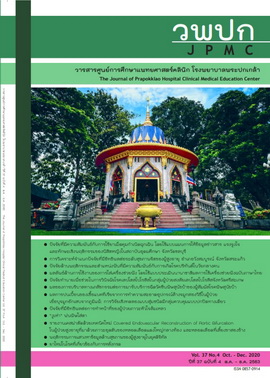Behavior Factors and Position of Teeth Related to Periodontal Disease in Middle-aged Adults
Main Article Content
Abstract
Background: Periodontal disease is an inflammation of periodontal tissues, the most prevalent oral disease found in the middle-aged leading to tooth loss later in life.
Objectives: To study the factors related to periodontal disease in middle-aged adults who had 28 remaining teeth.
Materials and methods: This cross-sectional study collected data of patients who received dental treatment at the Faculty of Dentistry, Chiang Mai University. Among those patients, 50 met the inclusion criteria i.e. aged 40 – 59 years old and had 28 remaining teeth. The potential risk factors of periodontal disease were gender, age, medical history, smoking behavior, and full periodontal status at 168 positions. Multiple logistic regression was applied to analyse the association of periodontal disease and potential risk factors at 5% significant level. Odds Ratio (ORs) and its 95% confidence interval (95% CI) were used to describe magnitude of association.
Results: Factors related to periodontitis trends found were higher odds in female than male (OR 2.40, 95% CI 2.04 - 2.82). OR of periodontitis factors were 2.05 (95% CI 1.58 - 2.66) and 1.61 (95% CI: 1.19 - 2.17) in smokers and former smokers compared to nonsmokers, respectively, 2.53 (95% CI 2.09 - 3.08) in diabetes patients compared to non-diabetes, and 0.92 (95% CI 0.91 - 0.92) in one-year increasing age. The high prevalence rates of periodontal disease were found in the interproximal sides, especially between molar teeth (40 - 52 percent). In terms of type and position of tooth, OR were 4.22 (95% CI 3.59 - 5.00) and 1.42 (95% CI 1.18 - 1.71) in molar and premolar teeth, respectively compared to anterior teeth, 3.61 (95% CI 3.02 - 4.31) in interproximal positions compared to non-interproximal positions, 1.34 (95% CI 1.17 - 1.53) in cheek-side positions compared to lingual-side, and 1.22 (95% CI 1.06 - 1.40) in mandible compared to maxilla.
Conclusion: The associated factors of periodontitis were smoking history, diabetes status, gender, age and tooth type, and tooth position; especially interproximal side between molar teeth which are the positions that may need more intensive procedure than a regular dental cleaning to prevent periodontitis.
Article Details
References
Genco RJ, Borgnakke WS. Risk factors for periodontal disease. Periodontol 2000 2013;62: 59-94
Limpawattana P, Sutra S, Thavornpitak Y, Wirasorn K, Chindaprasirt J, Mairieng P. Health situation analysis of hospitalized Thai older persons in the year 2010. J Med Assoc Thai 2012;95(Suppl 7):S81-6.
Srisilapanan P, Korwanich N, Jienmaneechotchai S, Dalodom S, Veerachai N, Vejvitee W, Roseman J. Estimate of Impact on the Oral Health-Related Quality of Life of Older Thai People by the Provision of Dentures through the Royal Project. Int J Dent 2016; 2016:1976013.
Urwannachotima N, Hanvoravongchai P, Ansah JP, Prasertsom P. System dynamics analysis of dental caries status among Thai adults and elderly. Journal of Health Research 2020;34:134-46.
Torrungruang K, Gongsakdi V, Laohaviraphab L, Likittanasombat K, Ratanachaiwong W. Association between cigarette smoking and the intraoral distribution of periodontal disease in Thai men over 50 years of age. J Investig Clin Dent 2012;3:135-41.
Andriankaja OM, Sreenivasa S, Dunford R, DeNardin E. Association between metabolic syndrome and periodontal disease. Aust Dent J 2010;55:252-9.
Eke PI, Dye BA, Wei L, Thornton-Evans GO, Genco RJ, Beck J, et al. Prevalence of periodontitis in adults in the United States: 2009 and 2010. J Dent Res 2012;91:914-20.
Timonen P, Niskanen M, Suominen-Taipale L, Jula A, Knuuttila M, Ylöstalo P. Metabolic syndrome, periodontal infection, and dental caries. J Dent Res 2010; 89:1068-73.
Cochran WG. Sampling techniques. New York: John Wiley & Sons; 1977.
Hujoel PP, Cunha-Cruz J, Banting DW, Loesche WJ. Dental flossing and interproximal caries: a systematic review. J Dent Res 2006;85:298-305.
Shiau HJ, Reynolds MA. Sex differences in destructive periodontal disease: exploring the biologic basis. J Periodontol 2010;81:1505-17.
Schulze A, Busse M. Gender Differences in Periodontal Status and Oral Hygiene of Non-Diabetic and Type 2 Diabetic Patients. Open Dent J 2016;10:287-97.
Kosaruk S, Sota C. The effects of dental health education program for preventing periodontal disease among health volunteers, Erawan district, Loei Province. Thai dental nurse Journal 2017;28(2) :1-12
Nishida N, Tanaka M, Hayashi N, Nagata H, Takeshita T, Nakayama K, Morimoto K, Shizukuishi S. Determination of smoking and obesity as periodontitis risks using the classification and regression tree method. J Periodontol 2005;76:923-8.
Arora M, Schwarz E, Sivaneswaran S, Banks E. Cigarette smoking and tooth loss in a cohort of older Australians: the 45 and up study. J Am Dent Assoc 2010; 141:1242-9.
Preus HR, Sandvik L, Gjermo P, Baelum V. Baseline adjustment and change revisited: effect of smoking on change in periodontal status following periodontal therapy. Eur J Oral Sci 2014; 122:89-99.
Lalla E, Papapanou PN. Diabetes mellitus and periodontitis: a tale of two common interrelated diseases. Nat Rev Endocrinol 2011; 28;7:738-48.
Taylor GW, Borgnakke WS, Graves DT. Association between periodontal diseases and diabetes mellitus. In: Genco RJ and Williams RC, editors. Periodontal disease and overall health: a clinician’s guide. Pennsylvania: Professional Audience Communications, Inc; 2010. p 83 – 104
Chávarry NGM, Vettore MV, Sansone C, Sheiham A. The relationship betwee diabetes mellitus and destructive periodontal disease: a meta-analysis. Oral Health Prev Dent. 2009;7:107-27.

